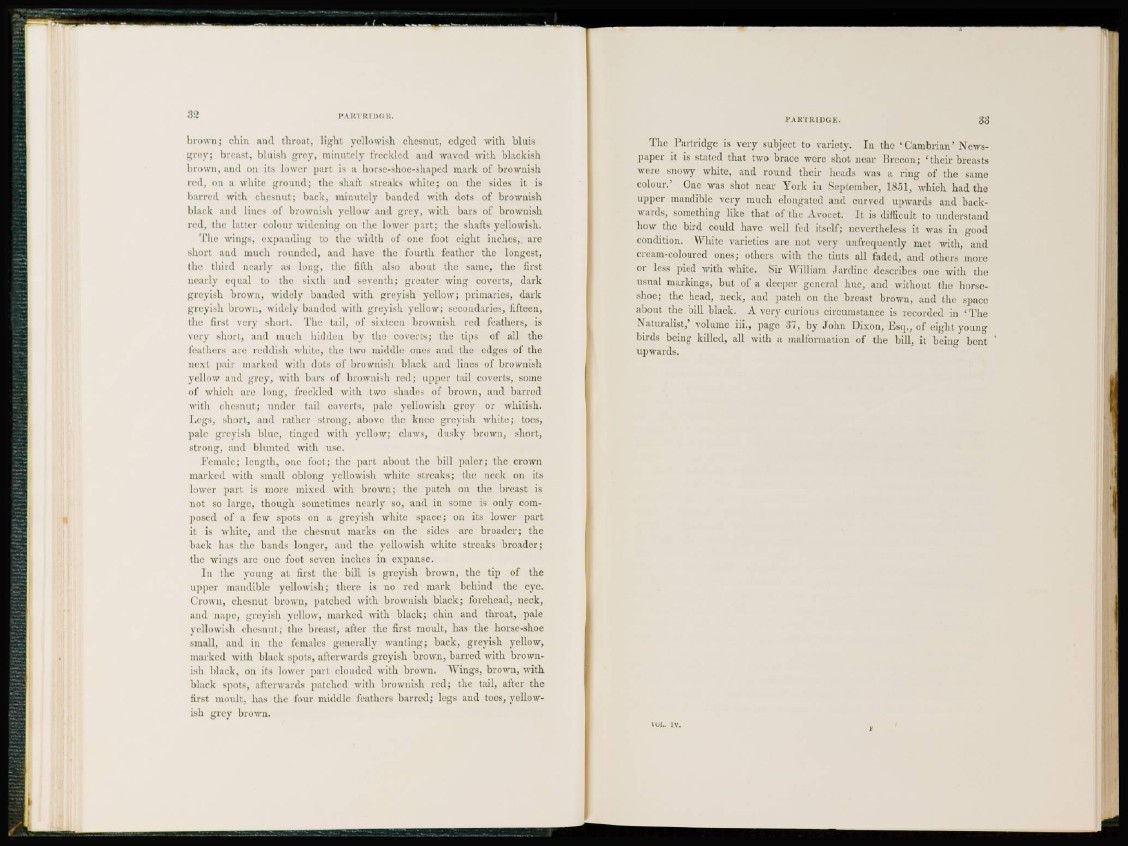
32 PARTRIDGE
brown; chin and throat, light yellowish chesnut, edged with bluis
g r e y ; breast, bluish grey, minutely freckled and waved with blackish
brown, and on its lower part is a horse-shoe-shaped mark of brownish
red, on a white ground; the shaft streaks white; on the sides it is
b a r r e d with chesnut; back, minutely banded with dots of brownish
black and lines of brownish yellow and grey, with bars of brownish
red, the latter colour widening on the lower part; the shafts yellowish.
The wings, expanding to the width of one foot eight inches,, are
short and much rounded, and have the fourth feather the longest,
the third nearly as long, the fifth also about the same, the first
nearly equal to the sixth and seventh; greater wing coverts, dark
greyish brown, widely banded with greyish yellow; primaries, dark
greyish brown, widely banded with greyish yellow; secondaries, fifteen,
the first very short. Tin? tail, of sixteen brownish rod feathers, is
very short, and much hidden by the coverts; the tips of all the
feathers are reddish white, the two middle ones and the edges of the
ne.\i pair marked with dots of brownish black and lines of brownish
yellow and grey, with bars of brownish red; upper tail coverts, some
of which are long, freckled with two shades of brown, and barred
with chesnut; under tail coverts, pale yellowish grey or whitish.
Legs, short, and rather strong, above the knee greyish white; toes,
pale greyish blue, tinged with yellow; elaws, dusky brown, short,
strong, and blunted with use.
Female; length, one foot; the part about the bill paler; the crown
marked with small oblong yellowish white streaks; the neck on its
lower part is more mixed with brown; the patch on the breast is
not so large, though sometimes nearly so, and in some is only composed
of a few spots on a greyish white space; on its lower part
it is white, and the chesnut marks on the sides are broader; the
back has the bands longer, and the yellowish white streaks broader;
the wings arc one foot seven inches in expanse.
I n the young at first the bill is greyish brown, the tip of the
upper mandible yellowish; there is no red mark behind the eye.
Crown, chesnut brown, patched with brownish black; forehead, neck,
and nape, greyish yellow, marked with black; chin and throat, pale
yellowish chesnut; the breast, after the first moult, has the horse-shoe
small, and in the females generally wanting; back, greyish yellow,
marked with black spots, afterwards greyish brown, barred with brownish
black, on its lower part clouded with brown. Wings, brown, with
black spots, afterwards patched with brownish red; the tail, after the
first moult, has the four middle feathers barred; legs and toes, yellowish
grey brown.
PARTIUDGK. 83
The Partridge is very subject to variety. In the ' C a m b r i a n ' Newspaper
it is stated that two brace were shot near Brecon; ' t h e i r breasts
were snowy white, and round their heads was a ring of the same
colour.' One was shot near York in September, 1851, which had the
upper mandible very much elongated and curved upwards and backwards,
something like that of the Avocct. It is difficult to understand
how the bird could have well fed itself; nevertheless it was in good
condition. White varieties are not very unfrequcntly met with, and
cream-coloured ones; others with the tints all faded, and others more
or less pied with white. Sir William Jardine describes one with the
usual markings, but of a deeper general hue, and without the horseshoe;
the head, neck, and patch on the breast brown, and the space
about the bill black. A very curious circumstance is recorded in ' T he
Naturalist,' volume iii., page 37, by J o h n Dixon, Esq., of eight young
birds being killed, all with a malformation of the bill, it being bent
upwards.